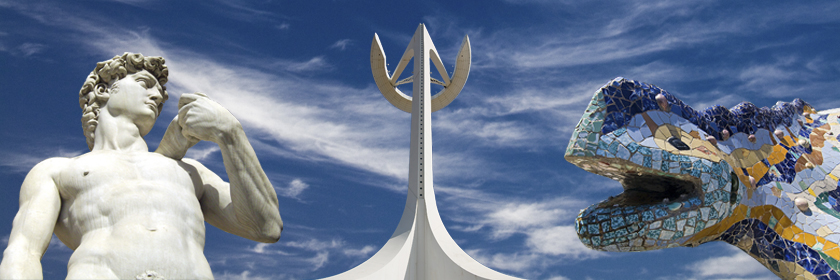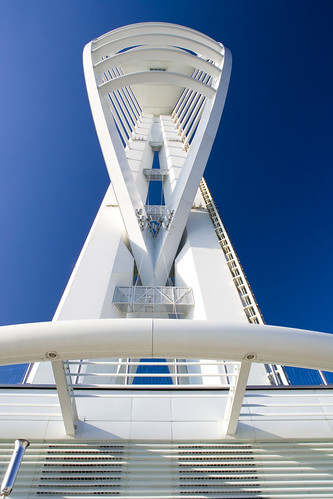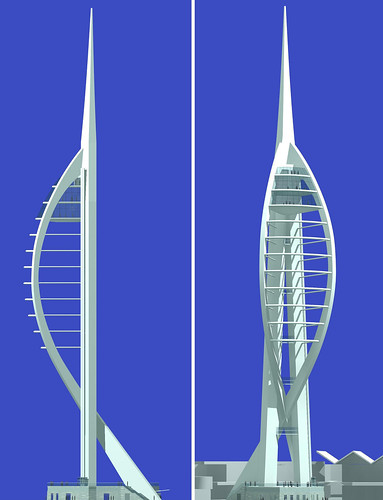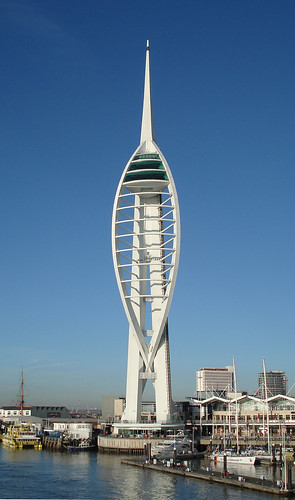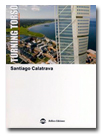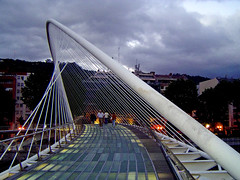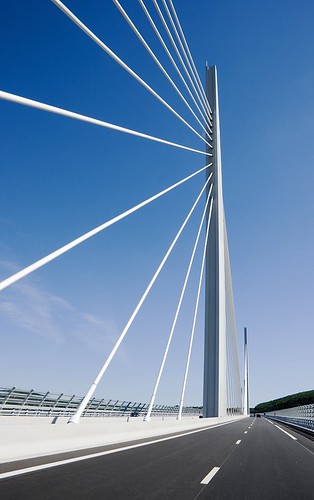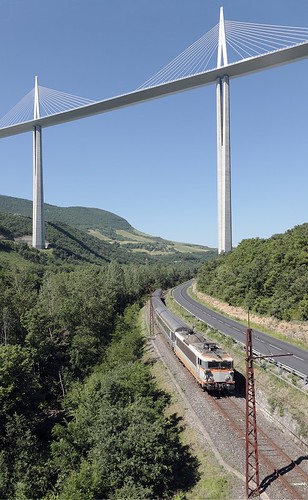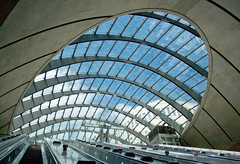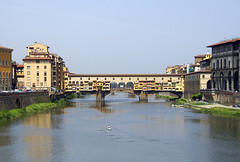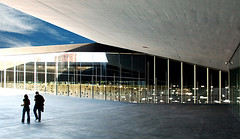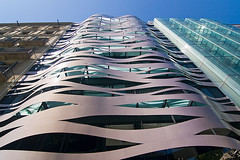ENGINEERS / SCOTT WILSON ENGINEERS
Spinnaker Tower
Portsmouth, Hampshire, England
HOME GEOGRAPHY ARCHITECTURE ENGINEERING SKYSCRAPERS
BRIDGES BUILDINGS TOWERS PUBLICATIONS ABOUT ME CONTACT
Copyright © José Miguel Hernández Hernández
Editor, Escritor y Fotógrafo de Arquitectura /
Publisher, Writer and Architectural Photographer
http://www.jmhdezhdez.com/ Leer más...
Etiquetas:
England,
HGP Architects,
Scott Wilson Engineers,
Spinnaker Tower,
United Kingdom
ARCHITECTS / HGP ARCHITECTS
Spinnaker Tower
Portsmouth, Hampshire, England
HOME GEOGRAPHY ARCHITECTURE ENGINEERING SKYSCRAPERS
BRIDGES BUILDINGS TOWERS PUBLICATIONS ABOUT ME CONTACT
Copyright © José Miguel Hernández Hernández
Editor, Escritor y Fotógrafo de Arquitectura /
Publisher, Writer and Architectural Photographer
http://www.jmhdezhdez.com/ Leer más...
Spinnaker Tower, Portsmouth, England, 1995 – 2005

ESPAÑOL
Cliente: Autoridades Locales
Arquitecto: HGP Architects
Ingeniero Estructural: Scott Wilson Engineers
Categoría: Torre
Uso: Torre de Observación
Altura: 170 metros
Plantas: 4
El primer nombre oficial que se le daría a esta vanguardista atracción turística fue "Torre del Milenio de Portsmouth"; posteriormente se le cambiaría el nombre a como la conocemos hoy en día, "Spinnaker Tower". La famosa torre se encuentra localizada al sur de Inglaterra, concretamente en el importante puerto de Portsmuth, en Hampshire. El diseño está inspirado en la vela de un barco y recuerda a la forma del famoso hotel de siete estrellas de lujo de Dubai, el conocido por todos Burj Al Arab. La enorme estructura se compone básicamente de un núcleo vertical a modo de espina dorsal que soporta todo el peso de los tres niveles de observación con la ayuda de los dos arcos de acero. Estos dos enormes arcos están unidos a su vez por otros perfiles horizontales de acero que le confieren mayor rigidez y evitan que se produzcan oscilaciones dándole a la torre una mayor estabilidad.

La parte superior de la torre cuenta con tres niveles de observación y mirador desde los que se puede divisar una vista panorámica de 350º pudiéndose contemplar nada menos que 37 kilómetros a la redonda. En el primer nivel, que cuenta con el piso de vidrio más grande de Europa, los más atrevidos pueden tener la sensación de ir caminado por el aire; el segundo nivel dispone de varios módulos multimedia que muestran un poco la historia de este importante puerto sureño; el tercer nivel, al que se le llamó el “nido del cuervo”, dispone de un techo realizado con una malla de alambre a través de la que se puede sentir directamente el aire del exterior; de este modo se ofrece así una auténtica aventura para los visitantes gracias a la altura a la que se encuentran.
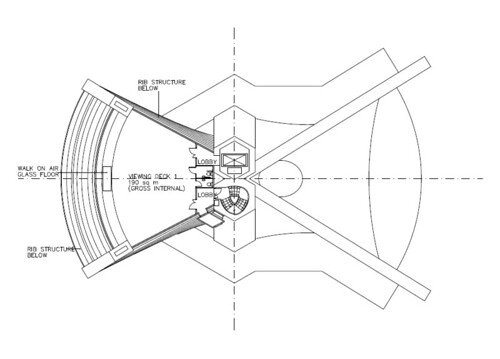
La moderna torre de observación también cuenta con una escalera triangular interior de evacuación y actualmente es la estructura más alta del Reino Unido fuera de Londres. Un ascensor lateral panorámico se incluyó después de su inauguración en el exterior, que se acondicionó fundamentalmente para el acceso a las personas discapacitadas y en caso de una posible emergencia. En el acceso principal, tres puertas giratorias nos conducen directamente a través de un gran hall a la ventanilla de billetes; posteriormente se puede acceder a otro distribuidor anexo donde se aloja el núcleo de ascensores que dan acceso superior a los tres niveles de observación y mirador.
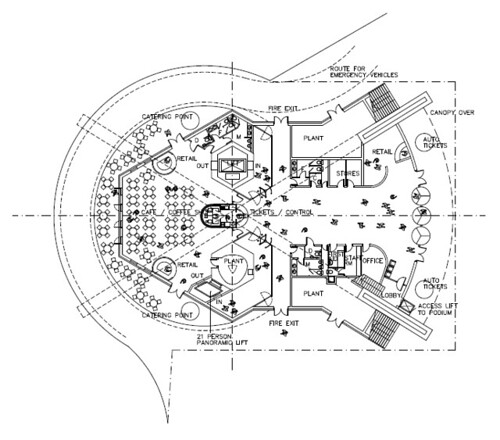
ENGLISH
Client: Local Authorities
Architect: HGP Architects
Structural Engineer: Scott Wilson Engineers
Categorie: Tower
Use: Observation Tower
Height: 558 ft
Floors: 4
The first official name would be given to this breakthrough tourist attraction was "Portsmouth Millennium Tower" was later changed its name as we know it today, "Spinnaker Tower". The famous tower is located in southern England, particularly in the important port Portsmuth in Hampshire. The design is inspired by a sail and reminds the shape of the famous seven-star hotel luxury in Dubai, the famous Burj Al Arab by all. The huge structure is basically composed of a core vertical mode backbone that supports the entire weight of the three levels of observation with the aid of two steel arches. These two huge arches are joined in turn by other steel horizontal profiles which give greater rigidity and helps prevent the tower oscillations giving greater stability.
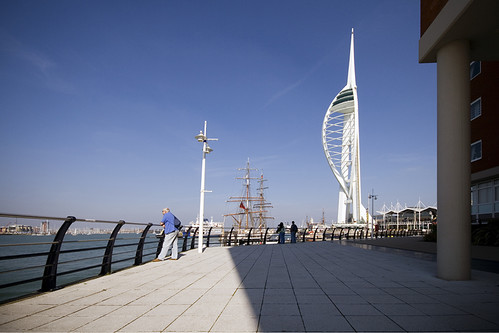
The top of the tower has three levels of observation and lookout from which you can see a panoramic view of 350 º posible to no less than 37 miles. At the first level, which has the largest glass floor in Europe, the most daring can have the sensation of walking on air, the second level has several multimedia modules that show some of the history of this important southern port and the third level, which was called the "crow's nest" has a roof made with a wire mesh through which you can directly feel the air outside and in this way is thus opened an adventure for visitors because of the height to which they are located.
The modern observation tower also has an internal triangular escape ladder and is currently the tallest structure in the UK outside London. A panoramic lift side was included after its opening in the exterior, which was fitted primarily for access to disabled persons and in case of an emergency. In the main entrance, three revolving doors lead directly to us through a large hall at the ticket window, after which you can access from another dealer annex which houses the core lifts that provide access to three levels higher look.
"Images Spinnaker Tower, Portsmouth, Hampshire, England",
Image 1 "Copyright © Doug Scobie", Photostream
Image 2 "Copyright © Neil O'Halloran", Image Flickr
Image 3-4-5-6 "Copyright © HGP Architects (Image Creative
Partnership and taken in 2008)", Web HGP Architects
Image 7 "Copyright © Steve Bullock", Photostream
Image 8 "Copyright © Andy Long", Photostream
"Text" Copyright © José Miguel Hernández Hernández
Editor, Escritor y Fotógrafo de Arquitectura /
Publisher, Writer and Architectural Photographer
Todos los derechos reservados / All rights reserved
http://www.jmhdezhdez.com/
Related articles / Artículos relacionados

Montjuic Tower
Barcelona, Spain
Santiago Calatrava
Oriental Pearl TV Tower
Shanghai, China
Shanghai Modern Architecture Design Co. Ltd.
CN Tower
Toronto, Ontario, Canadá
John Andrews International & WZMH Architects
Space Needle
Seattle, Washington, USA
John Graham & Associates
MUY IMPORTANTE!!! VERY IMPORTANT!!!
Deja tu comentario sobre este reportaje al pie de este post donde dice "Publicar un comentario en la entrada"; me será de gran valor para seguir mejorando este sitio web y te contestaré con la mayor brevedad posible... Muchas gracias!
No obstante, si te ha resultado interesante este reportaje y también el Blog en general, por favor, no dudes en hacerte Fan de la página de Fans del Blog de José Miguel Hernández Hernández en Facebook aquí
Nota importante: Una vez que hayas entrado en la página de Fans del Blog en Facebook, con sólo hacer click en el botón de "Me gusta", a partir de ese momento estarás al tanto de todos los nuevos reportajes interesantes relacionados con la Arquitectura y la Ingeniería que aquí se vayan publicando para no perder ningún detalle...
También puedes suscribirte por e-mail (te llegaría un e-mail con el enlace de cada artículo en el mismo momento en que sea publicado), o bien también puedes seguir el Blog a través de Twitter aquí
Nos vemos en el Blog!
Leave a comment on this story at the bottom of this post where it says "Post a comment in the entry", I will prove invaluable to further improve this website and I will answer as soon as possible .. . Thank you very much!
However, if you this story was interesting and the blog in general, please do not hesitate to make Fan Fans of the Blog page José Miguel Hernández Hernández on Facebook here
Very important: Once you enter the page Blog fan of Facebook, simply click on the button Like "From that moment you are aware of all new interesting stories related to the Architecture and Engineering are published here to avoid losing any detail ...
Can also subscribe by e-mail (I would e-mail with a link to each item in the same time it is published), or you can follow through Blog Twitter here
See you at the Blog!
HOME GEOGRAPHY ARCHITECTURE ENGINEERING SKYSCRAPERS
BRIDGES BUILDINGS TOWERS PUBLICATIONS ABOUT ME CONTACT
Copyright © José Miguel Hernández Hernández
Editor, Escritor y Fotógrafo de Arquitectura /
Publisher, Writer and Architectural Photographer
http://www.jmhdezhdez.com/ Leer más...
ENGINEERS / MARIO VILA VERDE
Juscelino Kubitschek Bridge
Brasilia, Brasil
HOME GEOGRAPHY ARCHITECTURE ENGINEERING SKYSCRAPERS
BRIDGES BUILDINGS TOWERS PUBLICATIONS ABOUT ME CONTACT
Copyright © José Miguel Hernández Hernández
Editor, Escritor y Fotógrafo de Arquitectura /
Publisher, Writer and Architectural Photographer
http://www.jmhdezhdez.com/ Leer más...
ARCHITECTS / ALEXANDER CHAN
Juscelino Kubitschek Bridge
Brasilia, Brasil
HOME GEOGRAPHY ARCHITECTURE ENGINEERING SKYSCRAPERS
BRIDGES BUILDINGS TOWERS PUBLICATIONS ABOUT ME CONTACT
Copyright © José Miguel Hernández Hernández
Editor, Escritor y Fotógrafo de Arquitectura /
Publisher, Writer and Architectural Photographer
http://www.jmhdezhdez.com/ Leer más...
Reggio Emilia Bridges, Bolonia, Italia, 2005-2007

ESPAÑOL
Cliente: Autoridades Locales
Arquitecto-Ingeniero: Santiago Calatrava
Tipo: Puentes atirantados
Localizados cerca de la zona industrial de Mancasale, los puentes de Reggio Emilia fueron encargados por las autoridades locales de Bolonia al arquitecto e ingeniero Santiago Calatrava para un proyecto de gran envergadura que vendría a solucionar diferentes enlaces y comunicaciones a las afueras de esta importante ciudad. El arquitecto solucionó el proyecto mediante tres puentes atirantados, dos de ellos gemelos y situados a ambos lados de un enorme puente central. El puente sur se sitúa cerca de una enorme rotonda mientras que el principal, que salva la Autopista A1 perpendicularmente, dispone de 50 metros de altura y esta situado en medio de los otros dos; este puente central está compuesto por un enorme arco atirantado de acero con dos ojos característicos en sus extremos; otro puente gemelo similar al de la rotonda se sitúa al otro lado.
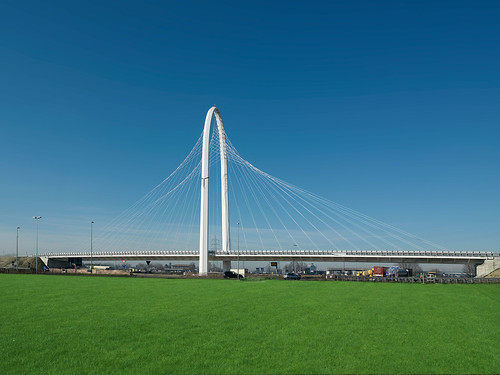
El enorme arco del puente central, que cuenta con más de 220 metros de longitud, logra sustentar el tablero mediante pares de cables atirantados de acero anclados a la parte inferior de la cubierta y en el mismo eje del puente. Este enorme arco, aparte de hacer de puerta de entrada para la importante ciudad, tiene la particularidad de que la fuerza axial de los tirantes de acero hace que se transmitan las cargas a ambos extremos del puente y de esta forma no se desplome el arco. Los otros dos tramos importantes del puente a ambos lados del central, disponen de un arco gemelo vertical que recuerda al proyecto de los puentes de Margaret Hunt Hill, en Dallas, USA, un proyecto que se encuentra aún en fase de construcción en la actualidad.
Para el diseño de los dos arcos gemelos verticales superiores en altura que el puente central, ya que disponen de 70 metros de altura cada uno, Calatrava se inspiró en la figura humana, ya que da la sensación de que el arco es la figura humana y los cables son los brazos que sustentan el tablero. Las dos pasarelas con arcos gemelos tienen un ancho de 15 metros para un tramo de 179 metros de largo y están realizados íntegramente en acero pintado en blanco. El proyecto se completa con una nueva Estación Ferroviaria que destacará en el horizonte cuando termine su construcción, ya que se basa fundamentalmente en una cubierta de color blanco impoluto que simboliza las ondas marinas, motivada esta por una escultura realizada por el arquitecto algunos años antes para el Museo de Meadows, en Dallas, Texas, USA.
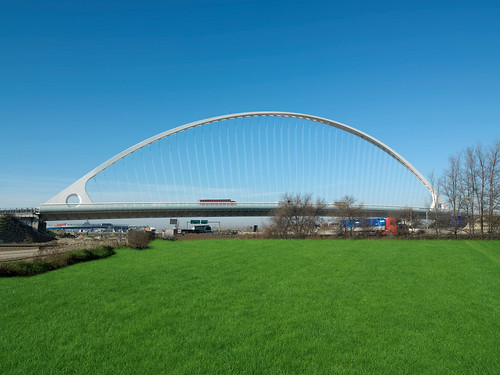
ENGLISH
Client: Local Authorities
Architect-Engineer: Santiago Calatrava
Type: Cable-stayed bridge
Located near the industrial zone Mancasale, Reggio Emilia bridges were commissioned by local authorities in Bologna to the architect and engineer Santiago Calatrava for a major project that would solve various communications links and on the outskirts of this important city. The architect solved the project by three cable-stayed bridges, two of them twins, and on both sides of a large central bridge. The south bridge is located near a big roundabout while the principal, which saves the A1 motorway at right angles, there are 50 meters high and is located in the middle of the other two main bridge consists of a huge steel tied arch characteristic with two eyes at their ends, another twin bridge similar to the roundabout is situated on the opposite side.
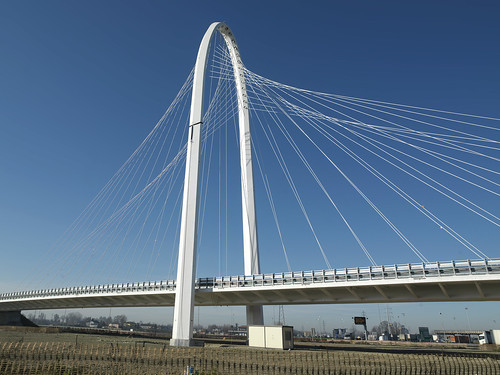
The huge central arch of the bridge, which has more than 220 meters long, able to support the board by pairs of cable-stayed steel cables anchored to the bottom of the deck and on the same axis of the bridge. This huge arch, apart from making a gateway to the major city, has the peculiarity that the axial force of steel braces makes loads are transmitted to both ends of the bridge and thus does not fall over the bow. The other two major sections of the bridge on both sides of the central arch have a vertical twin project reminiscent of Margaret Hunt Hill bridge in Dallas, USA, a project that is still under construction at present.
For the design of two twin arches in vertical height above the central bridge, because they have height of 70 meters each, Calatrava was inspired by the human figure, as it gives the impression that the bow is the human figure and cables are the arms that support the board. The two twin arched bridges have a width of 15 meters for a length of 179 meters long and are made entirely of steel painted white. The project is completed with a new railway station will outline in the horizon when his construction, as it relies heavily on a pristine white cover that symbolizes the sea waves, driven by a sculpture that the architect for some years before Meadows Museum in Dallas, Texas, USA.
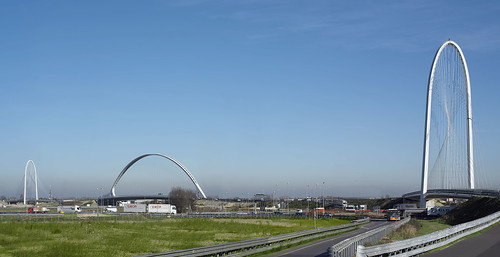
"Images Reggio Emilia Bridges" Copyright © Daniele Domenicali
Website: www.danieledomenicali.com
"Text" Copyright © José Miguel Hernández Hernández
Editor, Escritor y Fotógrafo de Arquitectura /
Publisher, Writer and Architectural Photographer
Todos los derechos reservados / All rights reserved
http://www.jmhdezhdez.com/
References / Referencias
Santiago Calatrava-Turning Torso
Bellisco Ediciones, Madrid, 2008
by José Miguel Hernández Hernández
Español - English
+info
Related articles / Artículos relacionados
Puente del Alamillo
Sevilla, Andalucía, Spain
Pasarela Campo Volantín
Bilbao, Spain
Aeropuerto de Sondica
Bilbao, Spain
HSB Turning Torso
Malmo, Sweden

Sundial Bridge
Redding, California, USA
MUY IMPORTANTE!!! VERY IMPORTANT!!!
Deja tu comentario sobre este reportaje al pie de este post donde dice "Publicar un comentario en la entrada"; me será de gran valor para seguir mejorando este sitio web y te contestaré con la mayor brevedad posible... Muchas gracias!
No obstante, si te ha resultado interesante este reportaje y también el Blog en general, por favor, no dudes en hacerte Fan de la página de Fans del Blog de José Miguel Hernández Hernández en Facebook aquí
Nota importante: Una vez que hayas entrado en la página de Fans del Blog en Facebook, con sólo hacer click en el botón de "Me gusta", a partir de ese momento estarás al tanto de todos los nuevos reportajes interesantes relacionados con la Arquitectura y la Ingeniería que aquí se vayan publicando para no perder ningún detalle...
También puedes suscribirte por e-mail (te llegaría un e-mail con el enlace de cada artículo en el mismo momento en que sea publicado), o bien también puedes seguir el Blog a través de Twitter aquí
Nos vemos en el Blog!
Leave a comment on this story at the bottom of this post where it says "Post a comment in the entry", I will prove invaluable to further improve this website and I will answer as soon as possible .. . Thank you very much!
However, if you this story was interesting and the blog in general, please do not hesitate to make Fan Fans of the Blog page José Miguel Hernández Hernández on Facebook here
Very important: Once you enter the page Blog fan of Facebook, simply click on the button Like "From that moment you are aware of all new interesting stories related to the Architecture and Engineering are published here to avoid losing any detail ...
Can also subscribe by e-mail (I would e-mail with a link to each item in the same time it is published), or you can follow through Blog Twitter here
See you at the Blog!
HOME GEOGRAPHY ARCHITECTURE ENGINEERING SKYSCRAPERS
BRIDGES BUILDINGS TOWERS PUBLICATIONS ABOUT ME CONTACT
Copyright © José Miguel Hernández Hernández
Editor, Escritor y Fotógrafo de Arquitectura /
Publisher, Writer and Architectural Photographer
http://www.jmhdezhdez.com/ Leer más...
Etiquetas:
Acero,
Bolonia,
cables,
calatrava,
fuerza axial,
Italia,
Mancasale,
ponte,
pontes,
Puente atirantado,
puente de arco,
puentes,
Reggio Emilia Bridges,
Santiago Calatrava,
steel
Canary Wharf Station, London, England, 1991-1999

ESPAÑOL
Cliente: Autoridades Locales
Arquitecto: Foster + Partners
Ingeniero Estructural: Ove Arup & Partners
Tipo: Transporte
Longitud: 300 metros
Con el fin de ampliar la red de metro Jubilee con once nuevas estaciones diseñadas por arquitectos de reconocido prestigio, las Autoridades Locales encargaban a Norman Foster el diseño de la estación mayor. La Estación de Canary Wharf se construyó donde se encontraba antiguamente el hueco de West India Dock, unos antiguos muelles bañados por el río Támesis que se han habilitado en la actualidad para enlazar las comunicaciones de la red de tren y metro en las inmediaciones de la nueva zona de Canary Wharf, un nuevo distrito financiero de la ciudad de Londres muy transitado con numerosos edificios altos.
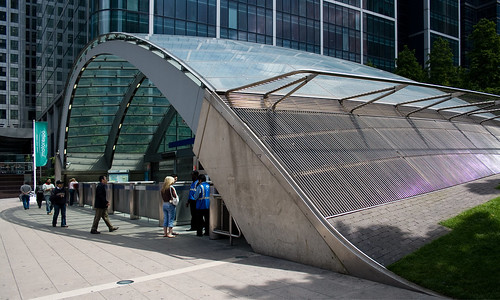
Lo más destacado de la nueva estación de metro de Canary Wharf son los accesos principales que se muestran como los únicos elementos visibles del edificio desde el exterior. Estas entradas están realizadas mediante diferentes cubiertas de acero y vidrio en forma de arco llamadas canopies, y que aparte de iluminar con luz natural el interior de la estación, se consiguió que los viajeros pudiesen identificar claramente las salidas hacia el exterior, evitando así la señalización direccional. Una de las particularidades de esta enorme estación es que se habilitó un parque con zonas ajardinadas para el ocio y el recreo en la cubierta del edificio.
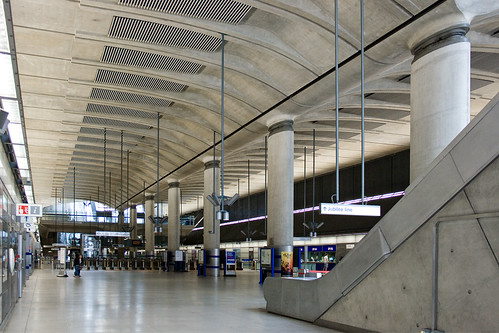

El interior del edificio se compone de un enorme espacio casi diáfano, debido a los diferentes niveles exigidos por el proyecto y cuenta nada menos que con 300 metros de longitud total, la misma longitud en altura que tiene la propia Torre de Canary Wharf diseñada por otro arquitecto de reconocido prestigio internacional, el argentino Cesar Pelli. La estación cuenta con 20 escaleras mecánicas dentro y fuera del recinto para ofrecer transporte rápido a los usuarios; las diferentes oficinas mientras tanto se situaron a ambos lados del vestíbulo principal para ofrecer claridad y calma en general a todos los viajeros.

ENGLISH
Client: Local Authorities
Architect: Foster + Partners
Structural Engineer: Ove Arup & Partners
Type: Transport
Length: 300 meters
In order to extend the Jubilee underground network with eleven new stations designed by internationally renowned architects, local authorities charged Norman Foster to design the senior season. Canary Wharf Station was built on the former pit of West India Dock, some old quays bordering the River Thames have been enabled at present to link the communications of the rail and underground network in the vicinity of the new Canary Wharf area, a new financial district in London very busy city with many tall buildings.

Highlights of the new underground station at Canary Wharf the main accesses are shown as the only elements of the building visible from the outside. These entries are made by different steel and glass covered arched canopies calls, and that apart from strikingly illuminate with natural light inside the station, passengers got could clearly identify the exits to the outside, avoiding and directional signage. One of the peculiarities of this huge station is enabled to be a park with landscaped areas for leisure and recreation in the roof of the building.

The building's interior consists of a huge space, almost diaphanous, due to the different levels required for the project and has no less than 300 meters in length, the same length that is the very height of Canary Wharf Tower designed by another international renowned architect, the Cesar Pelli. The station has 20 escalators inside and outside the enclosure to provide rapid transport to users, the different offices meanwhile placed themselves on both sides of the main hall to provide clarity and calm in general to all travelers.

All the images of the Canary Wharf Underground Station here
Drawings Copyright © Foster + Partners
"Images and Text Canary Wharf Station, London, UK"
Copyright © José Miguel Hernández Hernández
Editor, Escritor y Fotógrafo de Arquitectura /
Publisher, Writer and Architectural Photographer
Todos los derechos reservados / All rights reserved
http://www.jmhdezhdez.com/
Related articles / Artículos relacionados
Viaduct Millau
Aveyron, France
30 St. Mary Axe
London, United Kingdom
City Hall
London, United Kingdom
Hearst Tower
Manhattan, New York, USA
Millenium Bridge
London, United Kingdom
Moor House
London, United Kingdom
Others works in London / Otras obras en Londres
Maggie's Centre
London, United Kingdom
Rogers Stirk Harbour & Partners
Laban Centre
London, United Kingdom
Herzog & de Meuron
MUY IMPORTANTE!!! VERY IMPORTANT!!!
Deja tu comentario sobre este reportaje al pie de este post donde dice "Publicar un comentario en la entrada"; me será de gran valor para seguir mejorando este sitio web y te contestaré con la mayor brevedad posible... Muchas gracias!
No obstante, si te ha resultado interesante este reportaje y también el Blog en general, por favor, no dudes en hacerte Fan de la página de Fans del Blog de José Miguel Hernández Hernández en Facebook aquí
Nota importante: Una vez que hayas entrado en la página de Fans del Blog en Facebook, con sólo hacer click en el botón de "Me gusta", a partir de ese momento estarás al tanto de todos los nuevos reportajes interesantes relacionados con la Arquitectura y la Ingeniería que aquí se vayan publicando para no perder ningún detalle...
También puedes suscribirte por e-mail (te llegaría un e-mail con el enlace de cada artículo en el mismo momento en que sea publicado), o bien también puedes seguir el Blog a través de Twitter aquí
Nos vemos en el Blog!
Leave a comment on this story at the bottom of this post where it says "Post a comment in the entry", I will prove invaluable to further improve this website and I will answer as soon as possible .. . Thank you very much!
However, if you this story was interesting and the blog in general, please do not hesitate to make Fan Fans of the Blog page José Miguel Hernández Hernández on Facebook here
Very important: Once you enter the page Blog fan of Facebook, simply click on the button Like "From that moment you are aware of all new interesting stories related to the Architecture and Engineering are published here to avoid losing any detail ...
Can also subscribe by e-mail (I would e-mail with a link to each item in the same time it is published), or you can follow through Blog Twitter here
See you at the Blog!
HOME GEOGRAPHY ARCHITECTURE ENGINEERING SKYSCRAPERS
BRIDGES BUILDINGS TOWERS PUBLICATIONS ABOUT ME CONTACT
Copyright © José Miguel Hernández Hernández
Editor, Escritor y Fotógrafo de Arquitectura /
Publisher, Writer and Architectural Photographer
http://www.jmhdezhdez.com/ Leer más...
ENGINEERS / MICHEL VIRLOGEUX
Viaduct Millau
Aveyron, France
HOME GEOGRAPHY ARCHITECTURE ENGINEERING SKYSCRAPERS
BRIDGES BUILDINGS TOWERS PUBLICATIONS ABOUT ME CONTACT
Copyright © José Miguel Hernández Hernández
Editor, Escritor y Fotógrafo de Arquitectura /
Publisher, Writer and Architectural Photographer
http://www.jmhdezhdez.com/ Leer más...
Viaduct Millau, Aveyron, France, 1993-2004
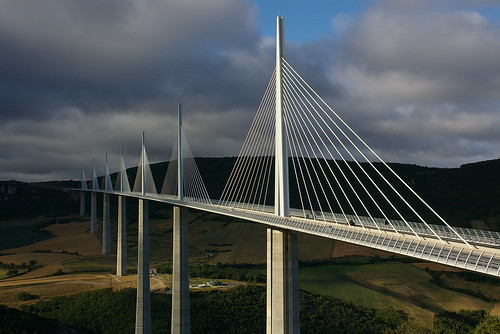
ESPAÑOL
Cliente: Autoridades Francesas
Arquitecto: Foster + Partners
Ingeniero: Michel Virlogeux
Longitud total: 2460 metros
Ancho: 32 metros
Tipo de puente: Atirantado
Salvando el río Tarn a una vertiginosa altura, el Viaducto de Millau se encargaría a Norman Foster para mejorar las comunicaciones en las inmediaciones cercanas al pueblo de Millau, en Aveyron, Francia. La enorme estructura, que combina como materiales el hormigón armado y el acero, cuenta con un ancho de 32 metros para ofrecer un servicio de dos carriles para cada sentido de tráfico rodado. El sustento del largo tablero de más de dos kilómetros de longitud, lo conforman siete pilares enormes rellenos de 85.000 m³ de hormigón armado. Son por tanto 205.000 toneladas de peso las que posee este fascinante puente atirantado que se ha convertido en un auténtico icono para Francia.

El pilar número dos (P2), consiguió el récord del mundo, ya que se sitúa a una altura de 244.96 metros, haciendo de este importante puente el más alto del mundo en la actualidad. En la parte superior de cada uno de los siete pilares se dejó un hueco en forma de v para aligerar el mismo. La estructura de terminación superior, que a modo de rombo gracias a las pilastras superiores, hace que las cargas se transmitan a la cimentación del viaducto aportando estabilidad al tablero. En la terminación con forma de v se apoyan las siete pilastras superiores que evocan claramente a la figura humana. El proceso de construcción fue bastante inusual, ya que después de construirse los enormes pilares de hormigón armado, se iban deslizando hacia el núcleo central las diferentes secciones que componen el tablero.

Cada uno de los siete pilares se encuentran separados entre sí por una distancia de 342 metros. Estos siete pilares junto con los tirantes de acero, logran sustentar el largo tablero de 2460 metros de longitud total. Con la construcción de este colosal viaducto emplazado en las inmediaciones del pueblo de Millau, las autoridades francesas esperan que pueda tener una vida útil de al menos 120 años. El puente más alto del mundo tuvo un coste total de 400 millones de euros, y sin lugar a dudas, no sólo ha ayudado a mejorar el tráfico en las inmediaciones de Millau, sino que además, se ha convertido en todo un símbolo para Francia.
El texto de este artículo se incluye en mi libro titulado "CONSTRUCCIONES FAMOSAS" / The text of this item is included in my book title "FAMOUS CONSTRUCTIONS" Español - English
by José Miguel Hernández Hernández
Publisher, Writer and Architectural Photographer
http://www.jmhdezhdez.com/
Video promotional
ENGLISH
Client: French Authorities
Architect: Foster + Partners
Engineer: Michel Virlogeux
Overall length: 2460 meters
Width: 32 meters
Type of bridge: cable-stayed
Saving the River Tarn at a dizzying height, the Millau Viaduct Norman Foster is responsible for improving communications in the vicinity near the town of Millau in Aveyron, France. The huge structure, and material that combines reinforced concrete and steel, has a width of 32 meters to offer a two-lane for each direction of traffic. The support of the long board over two kilometers long, is made up of seven huge pillars filled with 85,000 m³ of reinforced concrete. Are therefore 205,000 tonnes of weight which has this amazing suspension bridge that has become a true icon for France.
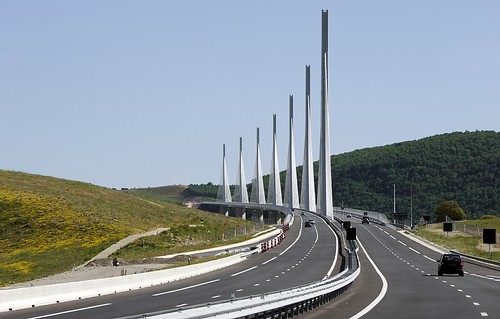
The pillar number two (P2), got the world record, because it lies at a height of 244.96 meters, making it important to bridge the highest in the world today. At the top of each of the seven pillars left a v-shaped hollow to lighten it. The upper end structure, which, like a diamond through the pillars above, makes loads transmitted to the foundation of the viaduct bringing stability to the board. On completion of v-shaped support over the seven pillars that clearly evoke the human figure. The construction process was quite unusual in that after constructing the massive concrete pillars, they were sliding towards the core of the different sections that make up the board.
Each of the seven pillars are separated by a distance of 342 meters. These seven pillars with steel braces, manage to sustain the long board from 2460 meters in total length. With the construction of this colossal viaduct located near the town of Millau, the French authorities expect to have a life expectancy of at least 120 years. The highest bridge in the world had a total cost of 400 million euros, without doubt, not only helped improve traffic near Millau, but also has become a symbol for France.
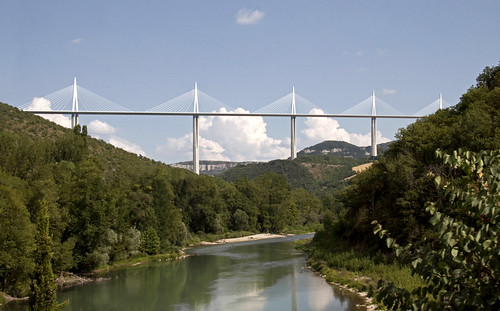
"Images Viaduct Millau, Aveyron, France"
Image 1 Copyright © Salvador Busquets, Image
Image 2 Copyright © Quim Bahí i Teixidor, Photostream
Image 3 Copyright © Laurent Jégou, Photostream
Images 4-5-6 Copyright © Dr. Tony Davies, Photostream
Image 7 Copyright © Tony Hisgett, Photostream
"Text" Copyright © José Miguel Hernández Hernández
Editor, Escritor y Fotógrafo de Arquitectura /
Publisher, Writer and Architectural Photographer
Todos los derechos reservados / All rights reserved
http://www.jmhdezhdez.com/
Related articles / Artículos relacionados
30 St. Mary Axe
London, United Kingdom
City Hall
London, United Kingdom
Hearst Tower
Manhattan, New York, USA
Millenium Bridge
London, United Kingdom
Canary Wharf Underground Station
London, United Kingdom
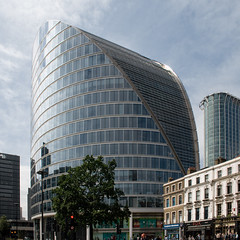
Moor House
London, United Kingdom
Others Cable-Stayed Bridge / Otros Puentes Atirantados
Harilaos Trikoupis Bridge
Athens, Greece
B. Mikaelian, VINCI & Others
Brooklyn Bridge
Manhattan, New York, USA
John Augustus Roebling
MUY IMPORTANTE!!! VERY IMPORTANT!!!
Deja tu comentario sobre este reportaje al pie de este post donde dice "Publicar un comentario en la entrada"; me será de gran valor para seguir mejorando este sitio web y te contestaré con la mayor brevedad posible... Muchas gracias!
No obstante, si te ha resultado interesante este reportaje y también el Blog en general, por favor, no dudes en hacerte Fan de la página de Fans del Blog de José Miguel Hernández Hernández en Facebook aquí
Nota importante: Una vez que hayas entrado en la página de Fans del Blog en Facebook, con sólo hacer click en el botón de "Me gusta", a partir de ese momento estarás al tanto de todos los nuevos reportajes interesantes relacionados con la Arquitectura y la Ingeniería que aquí se vayan publicando para no perder ningún detalle...
También puedes suscribirte por e-mail (te llegaría un e-mail con el enlace de cada artículo en el mismo momento en que sea publicado), o bien también puedes seguir el Blog a través de Twitter aquí
Nos vemos en el Blog!
Leave a comment on this story at the bottom of this post where it says "Post a comment in the entry", I will prove invaluable to further improve this website and I will answer as soon as possible .. . Thank you very much!
However, if you this story was interesting and the blog in general, please do not hesitate to make Fan Fans of the Blog page José Miguel Hernández Hernández on Facebook here
Very important: Once you enter the page Blog fan of Facebook, simply click on the button Like "From that moment you are aware of all new interesting stories related to the Architecture and Engineering are published here to avoid losing any detail ...
Can also subscribe by e-mail (I would e-mail with a link to each item in the same time it is published), or you can follow through Blog Twitter here
See you at the Blog!
HOME GEOGRAPHY ARCHITECTURE ENGINEERING SKYSCRAPERS
BRIDGES BUILDINGS TOWERS PUBLICATIONS ABOUT ME CONTACT
Copyright © José Miguel Hernández Hernández
Editor, Escritor y Fotógrafo de Arquitectura /
Publisher, Writer and Architectural Photographer
http://www.jmhdezhdez.com/ Leer más...
Suscribirse a:
Entradas (Atom)
